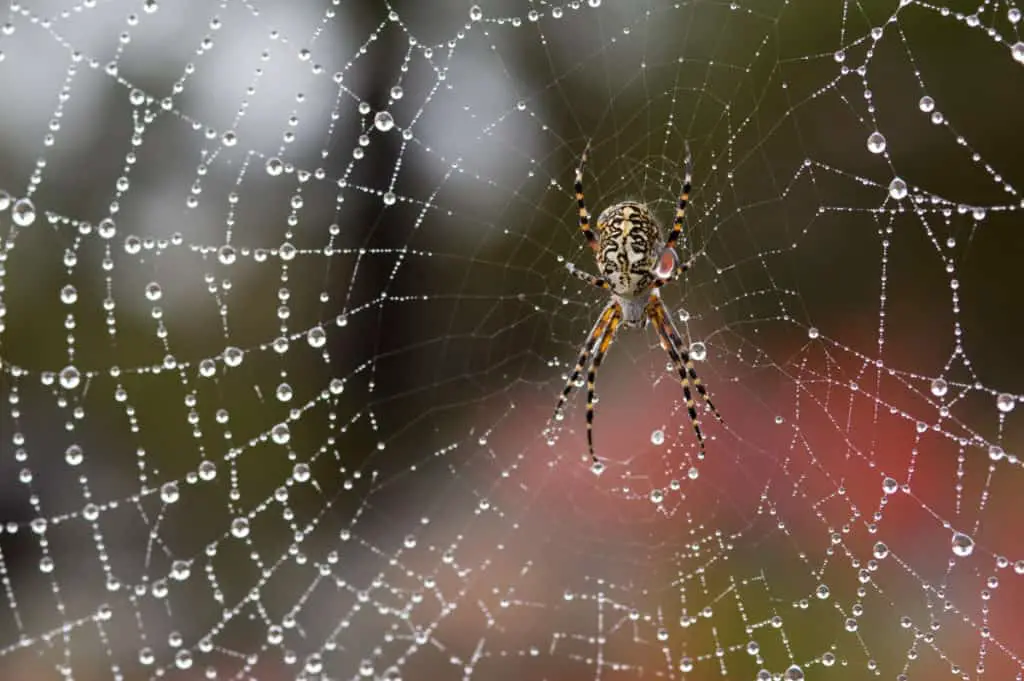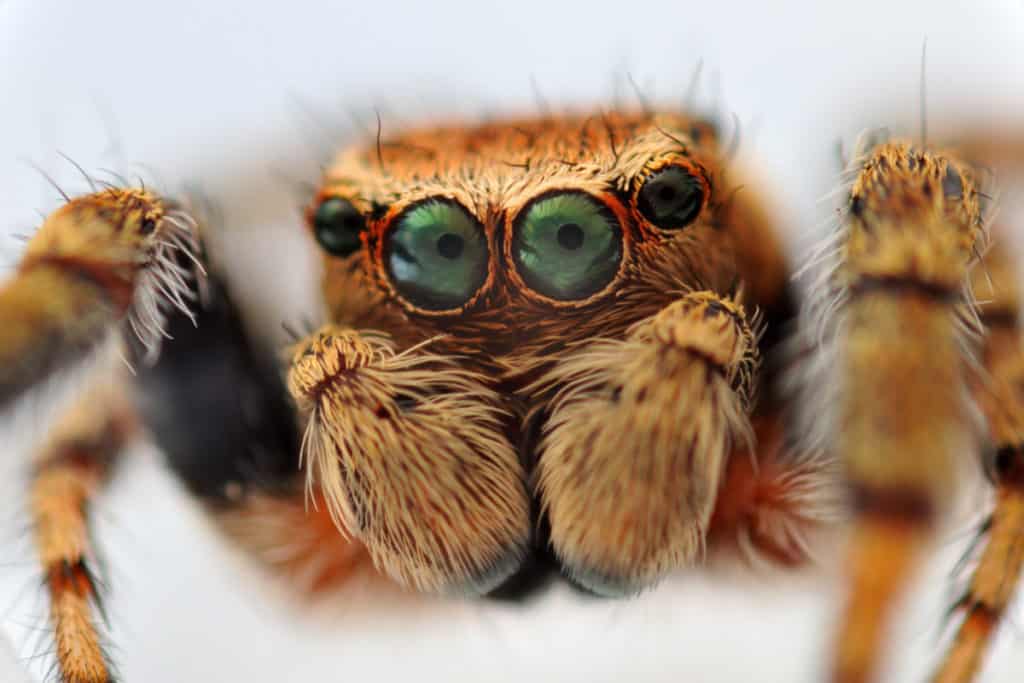Does the idea of a tarantula creeping its way to a puddle of clear rainwater and taking a sip seem strange? Is it difficult to imagine a spider slurping up drops of morning dew off her web?
Spiders do in fact drink water. They can drink from small puddles or droplets from rainfall. Dew, however, is a great source of water for spiders, especially those that make webs. Their webs are not only great for catching prey but also for collecting the evening dew.
The idea of spiders drinking water might seem odd because we do not get many opportunities to observe spider activities, or because it is hard to imagine something drinking when you cannot clearly see its mouth.

Which begs the question: What is in a spider’s mouth? Do all spiders drink water? How do spiders drink water? How much water do they need? And how long can a spider go without water?
We will explore these questions and all of their creepy-crawly details below.
The Anatomy Of A Spider’s Mouth?
Understanding a spider’s anatomy will go a long way in demystifying the idea of a spider drinking water. We are going to start right outside a spider’s mouth. Where insects like bees, and other creatures may have mandibles, spiders have chelicerae and pedipalps.
Chelicerae are large external jaws that sit in front of the cephalothorax (the spider’s head and throat). Attached to the chelicerae are two fangs of varying sizes (depending on the type of spider). For most spiders, a venom-producing gland sits in each fang or just behind it. The fang itself has a hollow point like a hypodermic needle, enabling a spider to inject venom into its prey.

In between the chelicerae, near the mouth are pedipalps. Pedipalps are like two tiny limbs. They have antenna-like abilities to feel and sense a spider’s environment while being strong enough to hold down prey (in some spiders). Some male spiders also use them to transfer sperm.
A spider’s mouth is directly behind the chelicerae and is made up of two cuticular plates, the labium (lower lip) and the labrum (upper lip). The mouth is tubular and surrounded by thick bristles called setae, giving the spider a hairy appearance.
Setae are cylindrical hollow structures similar to hair that can be found in many insects, spiders, and even deer. For spiders, the hair allows them to feel, taste, walk on walls, and filter their food. A spider’s mouth is full of these strange hairs.
We have another article that digs deeper into the anatomy of the spiders mouth. If you are interested in checking it out it is called, Do Spiders Have Tongues?
Do All Spiders Drink Water?
Typically spiders will drink water if there is an available source.
Given that spiders are carbon-based beings, we know that they need water to survive. But that doesn’t mean that they need to drink their water.
There are several animals such as the koala or the sand cat, that manage to stay hydrated without ever drinking water. The koala gets its water from eating eucalyptus leaves and the sand cat gets water from eating rodents.
Similarly, the black widow and the redback spider supposedly get all the water they need from eating their prey.
However, caretakers for these spiders have documented their spiders drinking freshwater despite having plenty of food sources.
So either these spiders occasionally require supplementing their diets with freshwater or they just enjoy drinking water when it is around.
How Do Spiders Drink Water?
Different types of spiders use unique combinations of webs, appendages, and mouths to ingest water, but for the most part, spiders slurp up water the same way they would slurp up their food.
Without tongues, spiders drink water by using their sucking stomachs to pump it up into their mouths and through their digestive system. The sucking stomach is an internal sack surrounded by contracting and expanding muscles. These muscles dilate the stomach rhythmically in the same way a person would squeeze a hand pump.
The effect is similar to a child using a straw to suck up the last bit of a milkshake.
Some spiders will also make use of their seta-covered pedipalps, using the strong hairs to pick up water droplets and transfer them to their mouth.
For many spiders such as the wolf spider, freshwater supply can be found in their environments, so scavenging for water droplets will suffice. But others have to be more creative to ensure they stay hydrated.
A spider’s web is central to many spiders’ freshwater supply. The structure and material of a spider’s web are specific to collecting water from the air and retaining it. Hence, the many stunning images of dew-covered spider webs. This provides condensation for spiders to drink even in dry environments.
The web of the orb-spider provides water beyond condensation. The silk of the web absorbs water from the atmosphere and the spider eats the water-rich web.
How Much Water Does A Spider Need?
Hydration needs are as particular to different types of spiders as the types of webs they build, as some are more thirsty than others. Some spiders (particularly young ones) need daily hydration and others only need water every few days or less. As a general rule, larger species of spiders need less water than smaller species of spiders.
What we do know is that hydration is particularly important for spiders because their exoskeleton. If the spider becomes dehydrated their exoskeleton does not function properly. We have written an whole article the spiders exoskeleton if you are interested. The article is called, Do Spiders Have Bones?
Though there is not a lot of specific information on spiders’ drinking habits, most spider caretakers recommended having freshwater continuously available for all types of spiders.
How Do You Provide Water For Your Pet Spider?
Pet spiders need to have a fresh water source available so they can get a drink of clean water when they need it. This can be done in a number of ways. Here are some options if you a looking at getting a pet spider:
- A small dish or water bowl
- A small plastic bottle cap
- A damp sponge
- A spray bottle
The size of the spider will determine the best way to provide your spider with enough water. The dish or bowl of water and the small bottle cap provide a 24/7 water supply. The small bottle cap is great for small spiders with the dish or bowl better for larger spiders. This is perfect for beginner spider owners.
The damp sponge is good as well providing the spider with small amounts of water to drink. It does however have to be regularly physically checked to ensure it is still damp rather than the visual check that can be done on the previous method.
The spray bottle can be used to mist water into the spider’s enclosure. This mimics evening dew drops with small drops of water forming on their webs and other structure in the enclosure. Your spider can then grab a drink of water from the drops that have formed.
One warning when using the spray bottle is don’t overdo it. Too much water sprayed too often will make the enclosure very damp which most spiders don’t like.
If your wondering what happens if you have a bowl of water in your enclosure and your spider falls in, you wouldn’t be alone. This is a question we have answered in another article, Can Spiders Swim? Let’s See Who Can and Who Can’t.
How Long Can A Spider Go Without Water?
While the length of time a spider can survive without water is highly dependent on its species, the majority of spiders can survive somewhere between 30-60 days without food and water. Presumably, a spider could live considerably longer if provided food, but there is no clear data.
There are numerous accounts of pet owners claiming that their spiders (typically tarantulas) have lived 12 months or more without food or water.
Experiments conducted by an extermination company found that brown recluse spiders can survive up to ten months in a sealed plastic box without food or water.
Did you know that there is a species of spider that can live for decades? We have written an article about it called, How Long Do Spiders Live? One Species Can Live For Decades
How Can Spiders Survive So Long Without Food Or Water?
Spiders have an amazing ability to regulate their metabolism and store extra nutrients.
The skill to regulate their metabolism enables spiders to slow their bodies down, reducing their need for food or water according to availability.
These fascinating creatures are also able to hold extra food and water reserves in their foregut, a small stomach directly in front of the sucking stomach. And in their midgut caeca, a branching sack fills the available space in a spider’s abdomen.
When a spider is provided with an abundance of food it will store the excess food as caeca liquid. As the midgut caeca fill with nutritious liquid the spider’s abdomen expands, providing plenty of room for extra reserves.
We do have a whole article called, How Long Can Spiders Live Without Food? on this topic if you want to know more about it.
The Wrap Up
Although different spiders act differently and therefore have different requirements when it comes to water, most spider keepers and researchers agree on the topic.
Even though spiders have a unique ability to go a long time without water, it is clear, from the first-hand accounts of those closest to these creatures, that given the choice spiders will drink water.
If you have found this article helpful then you might be interested in these articles we have written also:
Can Spiders Swim? Let’s See Who Can and Who Can’t.
Sources
http://atshq.org/articles/Digestion.pdf
https://www.sciencedirect.com/topics/engineering/spider-web
https://www.chemistryworld.com/news/how-spider-silk-soaks-up-water/3001990.article
https://pethelpful.com/reptiles-amphibians/How-to-Care-for-A-Pet-Black-Widow-Spider
http://britishspiders.org.uk/bulletin/090804.pdf
https://australian.museum/learn/animals/spiders/spider-structure/
https://www.uky.edu/Ag/CritterFiles/casefile/spiders/anatomy/spideranatomy.htm
